

Below you will find a list of published books, links to Amazon, and samplers.
 Rodolfo Pardi is an author, classified chess player, instructor and arbiter of Italian Chess Federation.
Rodolfo Pardi is an author, classified chess player, instructor and arbiter of Italian Chess Federation.
His website: http://scacchi.vecchilibri.eu/
 http://www.facebook.com/IstruttoreDiScacchi
http://www.facebook.com/IstruttoreDiScacchi
![]() info at vecchilibri dot eu
info at vecchilibri dot eu
Author page on Amazon: http://www.amazon.com/-/e/B009AX8XAM
 Andrea Gori is an author, FIDE Candidate Master, instructor of Italian Chess Federation.
Andrea Gori is an author, FIDE Candidate Master, instructor of Italian Chess Federation.
His website: http://scacchi.vecchilibri.eu/
 http://www.facebook.com/MaestroDiScacchi
http://www.facebook.com/MaestroDiScacchi
![]() andrea.gori at fastwebnet dot it
andrea.gori at fastwebnet dot it
Author page on Amazon: http://www.amazon.com/Andrea-Gori/e/B009MZX19G
 Evelyne Nicod is a painter, illustrator, engraver.
Evelyne Nicod is a painter, illustrator, engraver.
Her website: http://www.gatteria.it/
 http://www.facebook.com/gatteria
http://www.facebook.com/gatteria
![]() info at gatteria dot it
info at gatteria dot it
Author page on Amazon: http://www.amazon.com/-/e/B0085AIST2
Biography
A series of short illustrated monographs, by me and by other Instructors of Scacchistica Milanese,
an Italian Chess Club, who present rarely treated matters, that we think useful to the novice and club player,
and essential to a good preparation.
Up till now the following have been published, in Italian unless otherwise noted, they are full of
diagrams, up to the limit to keep price at 0,99 $:
To help, notation is algebraic with figurines, one of the few ebooks with this feature!




 .
.
By clicking the title you go to Amazon description page, where you can also buy the book.
By clicking "sample" you go to some example within this book.
The following books are available in Italian only:
Chess Strategy, initial 4 lessons of a basic course, by Andrea Gori.
Chess Strategy part 2, lessons 5 to 10, by Andrea Gori.
Gocce di saggezza, many guidelines, mainly text, of no use to English speaking players.
Scacco gatto in due mosse, two short novels and many cat illustrations by Evelyne Nicod.
Gli ebooks seguenti sono in ITALIANO, potrete vedere gratuitamente le anteprime seguendo il link:
Qualcuno è anche publicato su Kobo come epub.
Chess Patterns, una scelta di schemi fondamentali di scacchi
Case critiche e opposizione
Gocce di saggezza
Visualizzazione

16 Stalemate

Right, a familiar Knight's jump position (the Queen and the King at a Knight's distance from each other).
It's a draw, the King is not under check and has no square to go, stalemate.
If you have only the King left, do not resign, but try to reach this position.
Do not lose hope because when your competitor is in time trouble, the game may result in a stalemate.
I've already seen this happen.
Left, a possible position of stalemate, where the King is not in check, but it has no legal moves.
This position can be reached by novice players, where the simple way of mating with Queen and King is not well
known, and/or the meaning of stalemate is not fully understood.


A series of 5 patterns, each looks different, but all White's Kings control b6, the Black's King has no legal moves, stalemate. Any of these stalemates may occur while moving the King or the Queen, so, be careful!
Sample games can be seen here: Stalemate http://scacchi.vecchilibri.eu/partite/stalemate.html
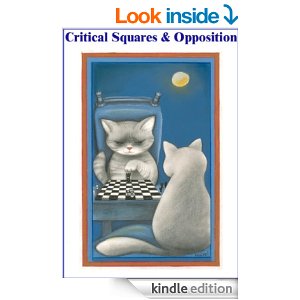
5 How to proceed
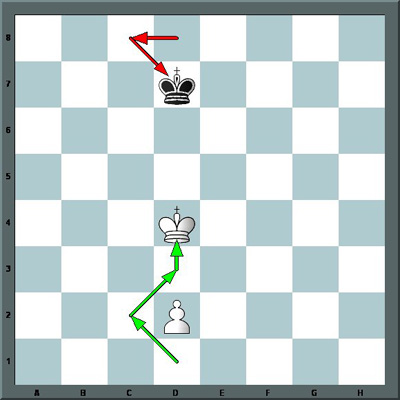
1.  c2!
c2!  c8 2.
c8 2.  d3
d3  d7 3.
d7 3.  d4
d4
White was able to reach a critical square, and with proper play is able to promote.
Easy up to here, isn't it? And would you have been able to do it? And would you have known the reason?
A possible continuation:
3. ...  d6 4. d3 takes back one tempo
d6 4. d3 takes back one tempo  c6 5.
c6 5.  e5
e5  d7 6.
d7 6.  d5
d5  c7 7.
c7 7.  e6
e6  d8 8. d4
d8 8. d4  e8 9. d5
e8 9. d5  d8 10.
d8 10.  d6
d6  e8
11
e8
11  c7
c7  f7 12. d6
f7 12. d6  f6 13. d7
f6 13. d7  e5 14. d8
e5 14. d8 1-0
1-0
6 Opposition
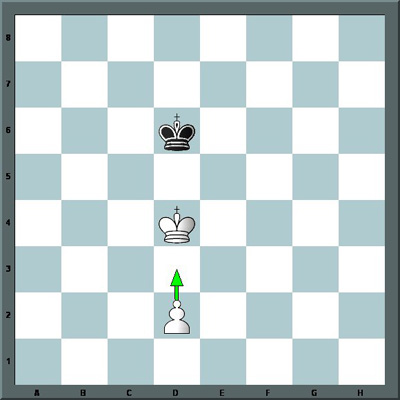
Second concept to understand, or at least remember, is Opposition.
When Kings are on squares of the same color, with only one square among them, the King which is NOT to move
has the opposition. IF it's the only piece that can move, the King must move away.
But in above diagram, Black, even if not to move after  d6, has NOT the opposition, as White can make the intermediate
move 3. ...
d6, has NOT the opposition, as White can make the intermediate
move 3. ...  d6 4. d3 taking back one tempo.
d6 4. d3 taking back one tempo.

Now it's White which has a real opposition, as Black is to move, ant it can only step back.
Black lost any hope, he can only step aside, and be pushed out, or step back, and White then steps forward, occupies again a critical square at two square distance from the pawn, and conquers the opposition again.
BLACKBURNE -->
Opening
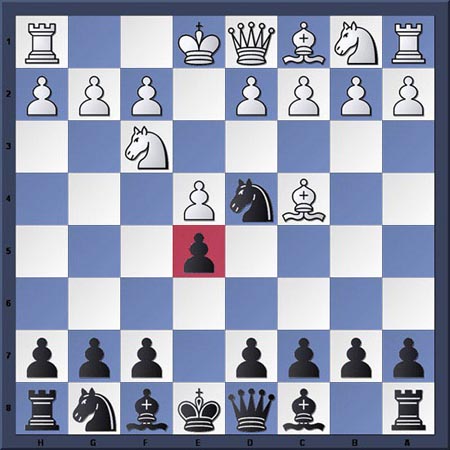
Opening develops in three moves, and can be considered an independent opening:
it begins as an Italian game (C50), and might lead to the Fried Liver or to other variants.
1. e4 e5 2. f3
f3  c6
3.
c6
3.  c4
c4  d4!?
d4!?
Black move  d4 is weak, leaving unprotected pawn e5, the bait.
d4 is weak, leaving unprotected pawn e5, the bait.
You could play this opening against:
- players of your level: if the bait is not swallowed, you will play a slightly weaker game,
with no material disadvantage, as with any opening which you do not know.
- against much stronger players. You would lose anyway against them, here at least you have a chance.
My personal experience, proven: I classified as 3N (the lower level in Italian federation,
but a success anyway) due to three games played this way in the tournament.
And in three friendly games with CM, two ended in 7 moves, and in the third I won a piece.
How can this happen? the aim of the winning black sequence is the capture of pawn e5 with the Queen, difficult to see so in advance. Besides, the stronger player will under-evaluate you, and will not do long analysis at the fourth move!
A last suggestion, even if you should usually play the board and not the player; anyway wait for a couple of minutes before making your third move.
This opening it's also called "Oh my God opening" by the exclamation of Black after the move, but that's considered an unfair trick!
4.  xe5?
xe5?
A really strong player (not so many), does not swallow the bait and does not capture e5, but simply develops, the three best moves will be shown later. His reasoning is that your move is weak, or by mistake, and he judges he will win anyway, or willingly, and suspecting a trap, he does not see any reason to fall in the trap and lose time in finding out what this is about.
The majority of players (nearly all) captures the pawn, even if Fritz rank of this move is the 17nth.
I try often to test a player, stating that this is a trap, and I ask players of all levels what the next black move could be: the answers are random, trying everything, not one gives the right (and only) answer. What would you move as black?

4. ...  g5!
g5!
When you move, I suggest you wait for a couple of minutes, not to show you know what you are doing.
The result is a double attack, to the Knight in e5 and to the pawn in g2. The final aim of this move
can hardly be detected, but the risk is high.
Many different replies are possible, resulting in losing one piece or even checkmate, should White not repent.
The possible replies will be shown in order of danger and frequency.

8 King fork


Simple basic patterns to be found in an endgame.
King attacks two unguarded pieces close together. Neither can move away and guard the other at the same time.
Upper right, same result if Knight in f5 is replaced by a Rook, and if King is replaced by a Bishop. Rook cannot go to f7 nor to h5 to protect the Knight, as it would be captured..

1 Illusory pin
Also known as Phantom Pin. This definition covers several Patterns, which have in common the pin which is
not real: the pinned piece is able to unpin, and often with a material gain, or can prepare a trap,
where loss of material can be awesome.
In the former case, many times the player is not aware of the error done, while the opponent is not aware that
he can get an advantage.
In the latter case instead, the trap is prepared, and even if the opponent does not fall in it, the resulting
position is favorable.
Unpinning starts the sequence.
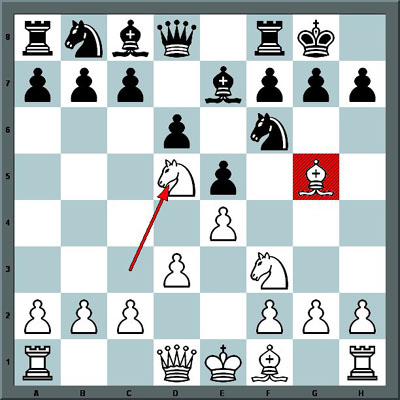
C42 Petroff defense
1. e4 e5 2.  f3
f3  f6 3.
f6 3.  c3 d6 4. d3
c3 d6 4. d3  e7 5.
e7 5.  g5 ? O-O 6.
g5 ? O-O 6.  d5 ?
d5 ?
Actually, after  g5 Knight
g5 Knight  f6 in not pinned, as it can move freely
with no consequence.
f6 in not pinned, as it can move freely
with no consequence.
And Bishop  g5 is in a dangerous position, as it is only apparently
protected (once), while it is attacked twice ( x ray) through the Knight
g5 is in a dangerous position, as it is only apparently
protected (once), while it is attacked twice ( x ray) through the Knight  f6:
it can be one target of a double attack.
f6:
it can be one target of a double attack.
Move  d5 is a mistake, it could be an outpost if black pawn were in c5
instead than in c7, and the light-squared Bishops were exchanged, here it could be
driven away by the pawn or the Bishop. The threat of a series of exchanges on f6 is meaningless.
d5 is a mistake, it could be an outpost if black pawn were in c5
instead than in c7, and the light-squared Bishops were exchanged, here it could be
driven away by the pawn or the Bishop. The threat of a series of exchanges on f6 is meaningless.
White is going to lose one piece.
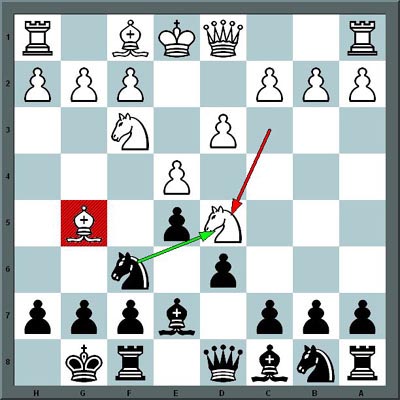
Viewed the other side around, from Black side
Clear? Isn't it?.
Black can without danger play Knight  f6, with a well timed double attack.
And anyway he can take advantageously and without any danger anything located on d5:
a strategic square, as it also defends e7, where he can go back if the Bishop is captured.
f6, with a well timed double attack.
And anyway he can take advantageously and without any danger anything located on d5:
a strategic square, as it also defends e7, where he can go back if the Bishop is captured.
 xd5! A possible continuation:
xd5! A possible continuation:
 xe7
xe7  xe7 ending a full Knight up.
xe7 ending a full Knight up.
exd5  xd5 that cannot be recaptured, ending a full Bishop up.
xd5 that cannot be recaptured, ending a full Bishop up.
Obviously avoid in this second case the error of recapturing with the Queen
 xe7??, as exd5 will follow, giving back the Knight.
xe7??, as exd5 will follow, giving back the Knight.
It's wise to always chose the right captures sequences, it's not mandatory to recapture with the piece
directly threatened. A frequent evaluation error (named "counting error" by Heisman).

C00 French opening
1. e4 e6 2. d4 d5 3. e5 c5 4. c3  c6 5.
c6 5.  b5
b5  d7 6.
d7 6.  f3 ?
f3 ?
 f3 is not protecting anything.
f3 is not protecting anything.
Now seen from the black side
Clear? Isn't it?
Black can without danger move his Knight  c6, with an advantageous double attack.
And anyway take advantageously and without any danger anything located on e5:
it is a strategic square, as it is in the meantime defending square d7, where it can go back if the Bishop
is captured.
c6, with an advantageous double attack.
And anyway take advantageously and without any danger anything located on e5:
it is a strategic square, as it is in the meantime defending square d7, where it can go back if the Bishop
is captured.
 xe5! A possible continuation:
xe5! A possible continuation:
 xd7
xd7  xd7 ending one full pawn up.
xd7 ending one full pawn up.
Remember to always choose the right sequence of captures:
it's not mandatory to recapture with the piece threatened.
A very frequent evaluation error.
 xe5
xe5  xb5 ending one full pawn up.
xb5 ending one full pawn up.
These positions are not even to be considered as traps, they are just unintentional errors, the cause being to have not recognized this typical Pattern.

The Pattern to remember.

Preliminary exercises

On an empty chessboard (it could be the above diagram on your Kindle), put a Knight on a1.
Move the the Knight to go to b1.
An additional example in the following page.

Now, bringing back the Knight to a1 each time, go to all the squares, counterclockwise and spiral wise. That is
 a1 b1,
a1 b1,  a1 c1,
a1 c1,  a1 d1, reaching all external square up to
a1 d1, reaching all external square up to  a1 a3,
a1 a3,  a1 a2. Next all internal squares:
a1 a2. Next all internal squares:  a1 b2,
a1 b2,
 a1 c2, and so on till you covered all the squares, up to the central squares.
a1 c2, and so on till you covered all the squares, up to the central squares.
Do not try to find all the possible ways to reach a square, one is enough.
Note your TIME, using the features of your Kindle to create a note, for comparison next time.
You should aim to do the complete tour in less than three minutes.
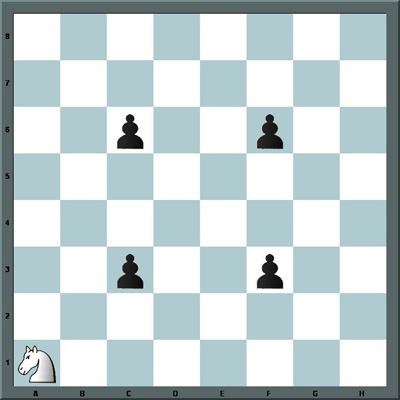
Next, put on the board four Black's pawns as shown, which forbid access to 8 threatened squares.
Do again the Knight's tour, avoiding landing on the squares where you would be captured
(and also avoid to capture a pawn, like a student did).
Note your TIME. Examples in the following page.


In the last example, it might help to know that you must reach h3 before g1.
If you feel like, try blind, without a board, a CM is able to do that.

How to play well the opening
Key elements to play well an opening is to know the purpose of an opening, the value of a sequence of moves and understanding typical positions, it's surely better to understand that to know by heart.
However the objectives must be established first:
one situation is the young boy where the aim is to bring him at Master level with a 20 hours weekly course lasting 5 years
another situation is the Candidate Master aiming to obtain the Master norm
still another is the club player (target of this handbook) who looks for amusement, would like to win many games
against players at his level, and eventually to classify.
Let us compare to scientific matters, namely mathematics: first a theorem is explained, then you are taught to apply it properly. The demonstration of the theorem, the most difficult phase, you are asked to understand it, learn it and explain it. You will forget the demonstration for the rest of your life, unless you become a teacher of that matter. But if you learn to apply it properly, it will be useful even if you are not able to explain the underlying reasons.
But while in mathematics there are laws, that is possible to demonstrate, in the Art of Chess (besides some endgame position) there are guidelines, general principles, and in commented games you find in books, the demonstration that a move stands better follows by the verification that all other moves are worst.
Therefore to play well an opening, it's essential to specialize, according to one's playing style, in two openings
with White (I suggest 1. e4) and two with Black, replying to e4 and d4.
These four main lines will be studied with the help of appropriate monographs, with all variants at least up to 5 moves
For most of all other openings, know the initial 5 moves of the more probable lines, programs like Fritz will
let you know the percentages, it's a waste of time to go after rare lines.
I will suggest how to choose a repertoire, remembering that there are easy openings and there are difficult opening, it was a widespread opinion about the Sicilian, that is better leave Fischer play it. You will also find here 4 complete repertoires that you can use like they are, or adapt to your own taste. Just an advice, it will take a long time to build another.
To be realistic and optimize the time dedicated to this leisure (to become professional there are full time courses that cover scientifically all aspects, theoretical knowledge and development of skill), besides training in tactics, the main factor up to class A, (tactics, tactics, and tactics), it's necessary to survive to the opening with an appropriate repertoire.
When you prepare your repertoire following a good monograph, you should identify the better moves, as established
by generations of Masters, do not reinvent the wheel. If you understand the reason, so much the better, but
if a move is the best, it's the best, however you put it.
The best advice you can get from this handbook, if you have established at the second move which is the best,
play it! even if you don't like it. Do not think you are a wiser guy in this special occasion, you would do a weak move.
Scandinavian B01

The Scandinavian Defense or Center Counter Defense is one of the oldest recorded openings, first recorded as being played between Francesc de Castellví and Narcís Vinyoles in Valencia in 1475 in what may be the first recorded game of modern chess, and being mentioned by Lucena in 1497. It is one of the oldest asymmetric defenses to 1.e4
Played by Black answering e4: 1.e4 d5. An opening very easy to learn, leads to a pawn structure that's always the same, characterized by two semi-open files: there is no weakness, your King cannot be attacked easily, and proceeding toward the middlegame, slowly Black will increase his mobility, and will have a better play.
Best White's answer is 2. exd5; moves refusing the main line are few, giving Black the advantage of limiting theoretical study.
We will use this opening to describe the method used to build a repertoire. Next chapters will show three additional important repertoires, as the result of a complete analysis and the initial 5 answers to most common openings.
Scandinavian defense is shown by Black's point of view, therefore, as indicated in introduction, the diagrams will be seen from the black side, for easier understanding (instead of the usual view from white side).
Scandinavian in its main lines is a good weapon especially for strategic players who prefer playing quiet positions and look for initiative
in later phases.
Portuguese and Icelandic variations are more fit to aggressive players.
By far one of the simplest openings for Black against 1. e4, as the pawn structure is created after two moves only. And the result is a single type of center, like no other opening, and a pawn structure consisting in a semi-open file* for each side.
Black loses one tempo* after Nc3, but the compensation is that all black pieces will have good squares to develop to. In this defense Black has no bad pieces*.
Pawn structure after e6 and c6 is very solid without weaknesses*. As in all other openings, White will have a space advantage, here with d4. However this pawn will be the target of attack by Black in the middlegame, along file d.
Another important aspect is that White has no way to attack Black's King.
It has however to be said that Black's position is slightly passive, without possibility of any early initiative. However there is no weakness, no bad pieces, no weak King side, nothing that could be attacked! And little by little the solid position will get better, while White will compromise his with unproductive actions.

1. e4 d5 2. exd5 93%  xd5 3. d4
xd5 3. d4  f6 4.
f6 4.  c3
c3  d6
d6
In this classic variation, White, before driving away the Queen with Nc3, prefers d4,
occupying the center.
However even if White would prefer to attack immediately the Queen gaining one tempo, it's simply a transposition of moves.
To play 3. d4 or 3. Nc3 results in the same variation.
In both events Black's plan is the following: the Queen recaptures the pawn and the is compelled to go back
or to be chased around the board. Therefore we prefer for White the following modern variation, the Knight
move at move 3.

Modern System, a first elementary tabia
1. e4 d5 2. exd5 xd5 3.
xd5 3.  c3 attacking immediately the Queen
c3 attacking immediately the Queen
 d6
{ Black's plan:
d6
{ Black's plan:  f6, c6,
f6, c6,  f5, e6,
f5, e6,  bd7, 0-0,
bd7, 0-0,  fd8}
4. d4
fd8}
4. d4  f6 5.
f6 5.  e3
e3 ge2 )
ge2 ) e2 c6 )
e2 c6 ) d3 )
d3 ) g5
g5  c6 )
c6 ) c4 c6 6.
c4 c6 6.  ge2
ge2  f5 7.
f5 7.  f4
f4  b4 )
b4 ) d2 b5 7.
d2 b5 7.  d3
d3  b7 8. f3 )
b7 8. f3 ) f3
f3  f6 {transposing to all other variants }
f6 {transposing to all other variants }White can choose many moves, but the same structure will be obtained, therefore we will consider the main variant.
1. e4 d5 2. exd5  xd5 3. d4
xd5 3. d4  f6
f6
(3...  c6 {!? only a short initiative })
c6 {!? only a short initiative })
4.  c3
c3
(4. c4  d8 5.
d8 5.  f3 { main line } g6
6.
f3 { main line } g6
6.  c3
c3  g7 7.
g7 7.  e2 O-O
8. O-O c6 9.h3 h6 )
e2 O-O
8. O-O c6 9.h3 h6 )
4...  d6
d6


You might be one piece down for several reasons, what will you do, resign? In a blitz game I saw stalemate the opponent while having two Queens and a pawn against a lonely King, so let's consider the situation before resigning.
Sometimes chess players resign a position which is not lost. Moreover, there are some examples where a game was resigned in a completely winning position!
A Sample game can be seen here, where Black resigned in a winning position: Resign http://scacchi.vecchilibri.eu/partite/resign.html
There are many reasons for being a piece down:
1) willingly. You do like, as I do, aggressive games, so gambit lines are preferred, you give a pawn and
as compensation you have better development and the initiative. You are not scared, as you are used
to play this way, but if your game is slowing down, the opponent exchanges a piece after another,
all of a sudden you find yourself in the endgame one pawn down, fighting for a draw.
2) with your great surprise, you took a bait, and found yourself a piece down following an opening trap
you were not aware of.
3) as the result of a tactic
4) as an error of visualization during a sequence of captures, at your surprise on the board some piece is missing,
that should be there
5) what remains after an unsound sacrifice
6) a plain blunder, you left a piece unprotected, or worst you gave it freely away
7) worst of all, you are outperformed by your opponent in a long strategic sequence of small disadvantages, till
your pieces have no mobility, and finish trapped
What will you do, hang down your head and cry?
In this handbook you will find the correct approach to (try to) save the game: some guidelines, some techniques, some examples. Remember, never give up!
1 Gambits
You are a gambiteer who likes the fun and the stress. Better study well your gambits and play aggressively, once your opponent did exchange a couple of pieces and castled, you'll better know the other chapters of this handbook.
Two gambits will be shown, one for White, the Morra gambit, and one for Black, the Budapest Gambit, both accepted and declined.
They come from other books of mine, where the purpose was different. If you already know everything about them, just skip this section, there's enough additional material.Morra Gambit B21

Basic tabia
Even if the name comes from the French player who used to play around 1950, this Gambit was played by Blackburne in 1870.
It's an opening full of tricks, resulting in a fast win when Black is not prepared.
The idea (as most of similar gambits) is to sacrifice a pawn to speed up development before an attack to the
opponent's King.
It's a weapon against the Sicilian often plaid by strong players, or to somebody trying to emulate Fischer.
Advantages:
Opening theory is limited to less than 10 main lines
You and not Black will decide the opening line
You will likely take your opponent to uncharted territory
You will play in your field
Many chances of complications and sacrifices.
1. e4 c5 2. d4 cxd4 3. c3 dxc3
DELAYED, not to reveal your intentions 3.  f3 e5 4. c3 dxc3 5.
f3 e5 4. c3 dxc3 5.  xc3 d6 6.
xc3 d6 6.  c4
c4  c6 7.
c6 7.  b3
b3  d7
d7
DECLINED 3... d3 4. c4 {no haste to capture pawn c, a Maroczy bind is obtained}  f6 5.
f6 5.  c3 d6 6.
c3 d6 6.  xd3 e6
7.
xd3 e6
7.  f3
f3  bd7 8. O-O
bd7 8. O-O  e7 9. b3 O-O 10.
e7 9. b3 O-O 10.  b2 a6 11.
b2 a6 11.  c1 b6
c1 b6
DECLINED 3. ...  f6 4. e5
f6 4. e5  d5 transposition to Alapin
d5 transposition to Alapin
From now on you must attack, otherwise you will finish one pawn down.
Budapest Gambit (BG) D30

offering to play the BG
A usual suggestion is to play the board and not the player, but this is true only at higher levels of play.
While you will find White players move 1. e4 or other strange first moves when they are at an intermediate level,
when they are at expert level or above the most probable first move you will meet will be 1. d4 , less dangerous and more positional.
Many replies to 1. d4 are available, and we assume that your opponent has a greater rating.
If he's much stronger than you and you reply d5, he will destroy you; because he has a greater theoretical knowledge than you,
and surely he knows all the main and minor variations up to the tenth move.
You'd better move 1. ...  f6 , which is more flexible, in the sense that you haven't still declared
your intentions. You haven't committed yourself yet, it could be a delayed Queen Gambit, you could lead to a Trompowsky,
in any way you force your opponent to think.
f6 , which is more flexible, in the sense that you haven't still declared
your intentions. You haven't committed yourself yet, it could be a delayed Queen Gambit, you could lead to a Trompowsky,
in any way you force your opponent to think.
If he continues along this path, 2. c4, then you play 2. ... e5, the centenary Budapest Gambit.
Actually it's not a gambit proper, as you get back the pawn; it becomes an open game, full of tactics which can
embarrass who does not know it well. But one cannot study everything.
My experience and that of many Masters is that it is much better to play an opening considered slightly inferior,
but well known, compared to an opening believed sounder, where you do not know the development when theory ends.
1. d4  f6 2. c4 e5 .
Previous diagram. Black sacrifices a pawn to open the game and get an advantage in development.
f6 2. c4 e5 .
Previous diagram. Black sacrifices a pawn to open the game and get an advantage in development.
According to the main line the pawn will be regained later.
Patterns
We assume your opponent has more pieces and you are trying to draw. In the combinations shown, sometimes having the move may decide the outcome, good or bad.
Mind : unactive links

1 Bishop Queen King

In this tactic the Bishop attacks Queen and King lined up, the result being in any case the capture of the Queen.
According to the reciprocal positions, it's named, from left to right, pin, skewer, fork.
In the middle diagram, with Black to move, the black King is skewered by the white Bishop. This is an absolute skewer, because the rules of chess compel Black to get out of check (if possible). After Black chooses one of the handful of legal moves available, White will capture the black queen.
Because the skewer is a direct attack upon the more valuable piece, it is generally a much more powerful and effective tactic than the pin. The victim of a skewer often cannot avoid losing material (though it may be possible if, for example, either piece can give check, thereby forcing the skewering side to move out of check instead of being able to capture either piece, or if it is possible to move a less valuable piece in the way); the only question is which material will be lost. The skewer occurs less often than the pin in actual play. When it does occur, however, it is often decisive.
In the pin and the fork the Bishop must be supported. The opponent may capture the Bishop with the Queen which will be recaptured, or try some other tactic; anyway the Queen can move only along the diagonal and is not protecting anything.
These patterns do not just happen, but must be prepared, a general strategy being to force the opponent's pieces into position for subsequent tactic.
1.1 Elephant trap

The Elephant Trap is a faulty attempt by White to win a pawn in a popular variation of the
Queen's Gambit Declined.
This simple trap has snared thousands of players, generally amateurs.
The earliest recorded occurrence of the trap seems to be Karl Mayet vs. Daniel Harrwitz, Berlin 1848.
The trap 1. d4 d5 2. c4 e6 3.  c3
c3  f6 4.
f6 4.  g5
g5  bd7
bd7
In our days this opening sequence usually indicates that Black intends to play the Cambridge Springs Defense with
5. f3 c6 6.e3
f3 c6 6.e3  a5, but it can also lead to the Orthodox Defense if Black plays ...
a5, but it can also lead to the Orthodox Defense if Black plays ... e7.
e7.
5. cxd5 Black has set a trap with exd5 6.  xd5??
White thinks that the black knight on f6 is pinned to the queen and cannot be moved.
xd5??
White thinks that the black knight on f6 is pinned to the queen and cannot be moved.
6...  xd5! 7.
xd5! 7.  xd8
xd8  b4+ (diagram above)
b4+ (diagram above)
Black regains the queen as White has only one legal move to get out of check.
8.  d2
d2  xd2+ 9.
xd2+ 9.  xd2
xd2  xd8
xd8
Harrwitz played the equally good 8... xd8, intending 9...
xd8, intending 9... xd2+
xd2+
In this case the Bishop is defended, but that's not necessary if it checks the King which has no escape square.
You can play through this game and download the PGN here: http://scacchi.vecchilibri.eu/partite/elephant.html
1.2 Pinned Queen

 d7 forced, 1-0
d7 forced, 1-0
You can play through similar games and download the PGN here: http://scacchi.vecchilibri.eu/partite/queenskewer.html

This diagram shows a typical position where the a4-e8 diagonal is opened, and the White's Bishop giving check obliges the Queen to interpose and be pinned and be lost, as the Knight and Bishops are not in their initial squares, and cannot interpose (as it did happen in the Elephant trap above).
1.3 Forked Queen

Next move  e4+ forking King and Queen
e4+ forking King and Queen
You can play through this and other similar games and download the PGN here: http://scacchi.vecchilibri.eu/partite/queenfork.html

1.8 Bringing out the Queen


Black to move after 5.  b3 ?
b3 ?
Do not bring out your Queen too soon.
Usually a beginner tries the Scholar Mate when playing against another beginner, don't do that, he might know better than you!
Here he succeeds: Fool's Mate http://scacchi.vecchilibri.eu/partite/foolsmate.html
Here he is punished (should your visualization not be enough, use a chessboard to follow the moves):
1. e4 e5 2.  h5? Threatening e5
h5? Threatening e5  c6 protects e5 3.
c6 protects e5 3.  c4 attacks f7, the weakest square
protected only by the King, threatening the Scholar mate.
c4 attacks f7, the weakest square
protected only by the King, threatening the Scholar mate.
Algebraic notation: "?" is a weak move, an error
To avoid the mate: 3. ... g6 attacking the Queen 4.  f3 again a mate threat on f7
f3 again a mate threat on f7  f6
interposing 5.
f6
interposing 5.  b3 ?
the Queen aligns to the Bishop, still to threaten the capture of f7, this time by the Bishop.
b3 ?
the Queen aligns to the Bishop, still to threaten the capture of f7, this time by the Bishop.
White developed the Queen too early and goes on moving the same piece, worsening his game.
While Black developed correctly.
5. ...  d4!
d4!
Algebraic notation: "!" is a good move
White cannot play 6.  xf7+, as after 6. ...
xf7+, as after 6. ...  e7 7.
e7 7.  c4 b5! 8.
c4 b5! 8.  c5+ d6 he would lose a piece with no compensation.
c5+ d6 he would lose a piece with no compensation.
6.  c3 d5! 7.
c3 d5! 7.  xd5
xd5  xd5 8. exd5
xd5 8. exd5  f5 9. d3
f5 9. d3  b4!
b4!
Tactic: skewer Queen-King
Tactic: deviation 10.  xb4
xb4  xc2+ con
xc2+ con
Tactic: forking King and Queen. White resigns.
While the teaching manual of the Italian Chess Federation considers the above a demonstration of the error of bringing out the Queen early, as any decent chess manual will do, however the following Wikipedia page http://en.wikipedia.org/wiki/Wayward_Queen_Attack calls this "The Wayward Queen Attack ECO C20 (also known as the Parham Attack, Danvers Attack, Patzer Opening, Queen Kiddy, or Queen's Excursion)". Despite its amateurish appearance, the Wayward Queen Attack was played in two grandmaster (GM) tournament games in 2005. As White I would stick to the approved guideline, and keep the Queen quiet for a while.
A sample game can be seen here: Wayward http://scacchi.vecchilibri.eu/partite/wayward.html
Chess Patterns, una scelta di schemi fondamentali di scacchi

16 Stallo

Nota posizione di stallo a salto di Cavallo. Non perdete la speranza, specie se l'avversario è in Zeitnot, l'ho vista succedere.
La posizione in basso può succedere a principianti che non abbiano ben chiaro come dare matto con la Donna. L'ho vista recentemente in un Torneo Scolastico Regionale, in una squadra delle scuole primarie.
33 Arca di Noè

E poi c'è la cosiddetta Arca di Noè, classica quando viene impiegata la Donna, che costretta
a ritirarsi dopo un attacco incauto, permette l'imprigionamento dell'Alfiere.
L'esempio che precede deriva da una cattiva apertura nella Siciliana, dove incautamente l'Alfiere
attacca il Cavallo con  b5, come se fossimo in una Spagnola, e in seguito ad a6 arretra in a3 (posizione del diagramma).
Dopo b5,
b5, come se fossimo in una Spagnola, e in seguito ad a6 arretra in a3 (posizione del diagramma).
Dopo b5,  b3, c4 l'imprigiona.
b3, c4 l'imprigiona.
Oltre a quanto visto, conviene avere sempre una cautela assoluta col Nero nel catturare con la Donna il pedone b2, si potrebbe finire intrappolati.

6 L'opposizione

Il secondo concetto da capire, o almeno da ricordare, è quello dell'opposizione.
Quando i due Re sono su case dello stesso colore, con una sola casa tra di loro, quello che
NON ha la mossa, si dice che ha l'opposizione. SE è il solo pezzo che può muovere, il Re
deve allontanarsi.
Nel diagramma precedente, il Nero, pur non avendo la mossa dopo Rd6, NON ha l'opposizione, in quanto
il Bianco può fare la mossa intermedia 3. ...  d6 4. d3 riprendendo un tempo.
d6 4. d3 riprendendo un tempo.
Adesso è il Bianco che ha una vera opposizione, in quanto la mossa è al Nero, che può solo arretrare.

Il Nero non ha più speranza, può solo andare di lato, e venire sbattuto fuori, o retrocedere, e il Bianco allora avanza, rioccupando una casa critica distante due case dal pedone, e riprendendo l'opposizione.

12 L'apertura
L'ECO, Encyclopedia of Chess Openings, raccoglie 500 aperture codificate, identificate da una lettera da A a E e un numero da 00 a 99, con le mosse ritenute valide per le varianti principali, è un testo di riferimento per le analisi, più che per imparare a giocare. Esistono libri completi, che invece descrivono le aperture principali, diciamo una trentina, con il loro scopo e le ragioni delle mosse di apertura. Esistono poi monografie per le singole aperture, che considerano tutte la varianti, da una decina a molte decine. Li troverete sul catalogo de Le Due Torri, consultabile on line. L'offerta maggiore è ovviamente in inglese.
Per il principiante comunque serve poco leggere a fondo una monografia di questo tipo, ne uscirà confuso, e non ricorderà niente quando sarà davanti a una scacchiera, nemmeno lo scopo di quella apertura specifica. Ed è una opinione diffusa che non serve a niente imparare a memoria le prime mosse.
Non esistendo negli scacchi (a parte qualche finale) delle leggi di valore generale, dimostrabili e ripetibili, come nelle discipline matematiche, si adottano dei cosiddetti "principi generali", che sarà bene applicare, anche se i giocatori esperti sanno quando si può deviare, in particolare in presenza di principi discordanti contemporanei.
Ecco un elenco parziale, che vi converrà seguire:
- occupare il centro, fisicamente o controllando le case d4, d5, e4, e5
- sviluppare rapidamente e armoniosamente i pezzi (sui due fianchi), nell'ordine, cavalli (verso il centro),
alfieri su una diagonale , torri su colonne "c" e "f" ( a meno di un attacco prematuro in seguito a gioco inesatto dell'avversario)
La ragione è che mentre inizialmente le case ideali per il Cavallo sono c3 ed f3, quelle per l'Alfiere vanno decise più
avanti nelle partite. Addirittura i Maestri aspettano qualche mossa prima di posizionare l'Alfiere di Donna.
- mettere in sicurezza rapidamente il proprio Re con l'arrocco (si mette anche in gioco una Torre con una mossa sola).
La ragione è che se il Re resta in centro può essere esposto a attacchi violenti.
- il difensore arrocca dopo l'attaccante, per decidere da quale parte arroccare
- non indebolire l'arrocco avanzando i pedoni in difesa, ma utilizzare i pezzi
- evitare di muovere due volte lo stesso pezzo (solo nelle partite aperte) prima di aver mosso almeno una volta gli altri
- evitare di mettere in gioco troppo presto la Donna, che l'avversario attacca con guadagno di tempo*
- migliorare continuamente la posizione dinamica dei pezzi, cominciando da quelli di maggior valore
- approfittare di tutte le occasioni tattiche, se decisive e non in contraddizione totale col piano strategico
- cercare di mantenere il re avversario al centro, per sottoporlo ad attacchi che possono essere anche violenti
Dopo che sono stati mossi due pedoni e posizionati tutti i pezzi, grossolanamente 8 mosse, si può ritenere conclusa la fase di apertura. Una conseguenza è l'aprire il gioco solo dopo lo sviluppo e la mobilitazione di tutti i pezzi
Suggerimento:
Porreca, Giorgio - Manuale teorico-pratico delle Aperture. Vi servirà per la vita.
ECO - Small Encyclopedia of Chess Openings. Manuale di riferimento per quando sarete più bravi.
Basta questa versione ridotta delle 500 aperture catalogate.
13 Il mediogioco
È la fase che segue l'apertura, quando tutti i pezzi sono stati sviluppati, si è cercato di occupare il centro, e si è messo in sicurezza il re con l'arrocco.
In questa fase praticamente tutti i pezzi sono ancora sulla scacchiera e bisogna sviluppare un piano, un'idea che ci porti a concretizzare qualche tipo di vantaggio. Piano che si basa suul'analisi di alcuni elementi, e dipende dalla struttura dei pedoni, dai vantaggi di spazio, dal tipo di arrocchi, da considerazioni strategiche.
Queste considerazioni difficilmente sono messe in atto dal principiante, almeno fino alla seconda categoria (2N): è un dato di fatto che la quasi totalità delle partite fino a questo livello sono il risultato di errori e tatticismi, tanto che si dice a ragione che le tre cose più importanti sono tattica, tattica, e ancora tattica.
Qualche "principio generale", tenendo presente che nel mediogioco i principi generali hanno meno importanza di un
obiettivo di attacco contro il quale lanciare tutte le forze disponibili.
Ci sono elementi che anche il principiante deve tenere presente:
- con un vantaggio di spazio, impedire all'avversario di liberarsi del suo spazio ristretto
- l'apertura delle linee* giova solo alla parte più forte. Nelle posizioni inferiori è incauto al massimo grado per
il difendente permettere l'apertura di linee
- in una posizione equilibrata, il forzare porta alla sconfitta
- c'è un momento nel quale la posizione va rivista dal punto di vista della possibilità del finale
- creare un Pedone passato
- in partita aperta, non muovere due volte lo stesso pezzo.
- sviluppare i pezzi in case non attaccabili da pedoni.
- identificare una debolezza, ad esempio un Pedone isolato, o crearla!
- andare con la Torre sulla settima traversa
Suggerimento:
Euwe, Max - Judgement and Planning in Chess. Per esperti
Gori, Andrea - Chess Strategy, corso di strategia scacchistica per giocatore di club. Un buon inizio.
Visualizzazione e calcolo sono processi separati, cha hanno luogo nella mente.
La visualizzazione è un'immagine statica, come una fotografia.
Il calcolo è dinamico, come un film.
Jonathan Tisdall, Improve Your Chess Now
Non visualizzo pezzi reali
ma so dove sono.

Test di ingresso
Nella partita spesso è necessario calcolare concretamente delle varianti. Ovviamente a mente, non è concesso prendere appunti. La capacità di vedere nella mente le posizioni è di assoluta importanza, e può essere migliorata con appositi esercizi di visualizzazione.
TEST A
Usando la funzione di annotazione del Kindle, scivete le risposte alle seguenti domande:
1 Quale è il colore di b6?
2 Quale è il colore di g6?
3 Come può un Alfiere arrivare a b6 partendo da g4?
4 Tutte le vie più brevi per muovere un Cavallo da d4 a a8.
Risposte alla pagina seguente.
1 nero
2 bianco
3 non può
4 1 Cd4 - e6 - c7 - a8 2 Cd4 - b5 - c7 - a8
Se non avete risposto correttamente a tutte e 4 le domande, siete a livello principiante. Altrimenti fate il test seguente.
TEST B
1
Bianco: Rg1, Dd3, Cf8 Pedoni: b3, e5, g2, h2
Nero: Rh8, Dd2, Ac1 Pedoni: a4, b4, g7, h6
Mossa al Bianco
Mossa al Nero

Se Bianco Dh7#
Se Nero De1#
2
Posizione iniziale. Dopo 1. e4 c6 2. d4 d5 3.Cc3 dxe4 4. Cxe4 Cd7 5. De2 Cg f6
raccomandate la migliore mossa per il Bianco.
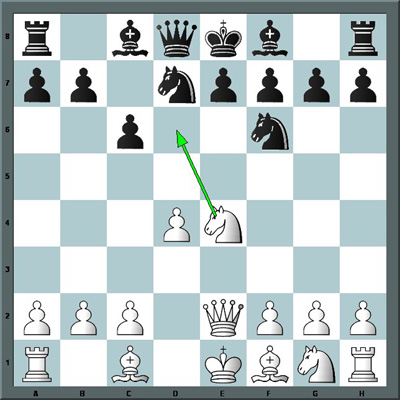
Cd6#
3
Bianco: Rg1, Da3, Td1, Ag5, Ce2 Pedoni:a2, b3, c4, f2, g2, h2
Nero: Rg8, Dg6, Tf8, Ab7, Ce5 Pedoni: a7, b6, c7, f7, g7, h7
Mossa al Bianco. Cosa?

Df8+, Rxf8, Td8#
4
Bianco: Rg1, Ag2, Ce4
Nero: Re3, Db2
Mossa al Nero. Può vincere? Come?

Il Nero non può vincere, perchè il suo Re non ha la possibilità di entrare nell'angolo per aiutare la Donna. Il Bianco muove semplicemente il Re nell'angolo. Un tipico esempio di pattern di fortezza.
Se non avete risposto correttamente a tutte le domande, siete al livello intermedio, e dovreste cominciare ad allenarvi
per la visualizzazione.
Se avete risposto a tutto, avete una buona visualizzazione, e potete migliorare la vostra abilità con esercizi specifici
avanzati.
- Prendete un libro con esercizi di tattica. Guardate al diagramma di una posizione per qualche tempo, per memorizzarla.
Dopo risolvete la combinazione con tutte le mosse candidate e le risposte dell'avversario.
- Leggete una partita senza guardare la scacchiera.
- Giocate partite di allenamento con qualche amico. Se è più debole dovrebbe giocare alla scacchiera dicendovi le mosse,
e dovreste rispondere senza guardare la scacchiera (ma annotando le mosse).
1 Esercizi preliminari
Diagramma 1.1 Salto di Cavallo

Su una scacchiera vuota (che può essere utilmente questa simulata del Kindle),
posizionate un Cavallo in a1. Muovete poi per andare in b1.
Esempio alla pagina seguente.
Diagramma 1.2

Ca1, Cc2, Ca3, Cb1
Adesso, riportando ogni volta il Cavallo in a1, andate in tutte le case, in senso orario e in spirale. Cioè
Ca1 b2, Ca1 c1, Ca1 d1, ... Ca1 a3, Ca1 a2, Ca1 b2, Ca1 c2, e così via fino ad avere coperto tutte le case.
Non cercate le varianti, basta un modo.
Segnate il TEMPO, utilizzando il sistema delle frecce centrali sul vostro Kindle, annotando sulla parola TEMPO.
In modo da confrontare la prossima volta.
Diagramma 1.3 Salto ad ostacoli

Cavallo bianco in a1 e pedoni neri in c3, c6, f3, f6
Organizzate la scacchiera con i quattro pedoni neri mostrati, che impediscono l'accesso di 8 case
attaccate. Ripetete di nuovo il giro di Cavallo, evitando di transitare per le case dove sareste catturati
(e anche, come ha fatto un allievo, di catturare un pedone).
Segnate il TEMPO. Esempi nella pagina seguente.
Diagramma 1.4

Ca1 Cc2, Ca3, Cb1
Diagramma 1.5

Ca1, Cc2, Cb4, Cd3, Cf4, Ch3, Cg1
Può aiutare nell'ultimo caso vedere che bisogna arrivare prima in h3.
Se ve la sentite, provate a mente senza una scacchiera davanti, un CM ce la fa.
Meet the artistic and whimsical cats of Evelyne Nicod
Published in CAT COLLECTORS (USA), August-September 1992, pages 4-5
Text: Evelyne Nicod
Translation revision: Marilyn Dipboye
Illustrations: © Evelyne Nicod
All rights reserved
I was born in France, March 17,1942. When I discovered that the art world would be where I would find my career, I began my studies, first in the Fine Art school in Besançon (France), then in Vevey (Switzerland) and one year in London at the Saint Martin School of Art. Later, I married in Italy and started working as a professional painter in Milano. It was there that I became interested in etching and knew that I had found my technique.
TECHNIQUE
It takes years of hard work to get a decent result, to understand the sensibility of a line on a zinc plate, the acid action, the printing and the thousand tricks to improve. I know I will never stop learning and it is the reason why it is so fascinating.
The real problem is the acid. I use a very slow one to control the process, etching the plate five or six times (or more) to get the very light and very deep contrasts. It requires a good concentration. I print every plate myself on my dear old press.
For printing I use a technique called " poupèe " , which means all the color shades on a single plate. It is very slow but the result is very personal. I make a black and white copy to see the contrast and two copies for the research of color; after that I start the definitive printing, making 50 prints for each plate. To draw a plate 13 " x 20 " takes me three months; then two days for etching in acid, and each print requires about 3/4 of an hour to ink. What I like in this art form is the freedom to obtain almost anything I fancy. The best (or the worst) is when I try my first print. The tension is high!
CATS CATS CATS
I had a marvelous grandmother; she loved flowers, plants, animals and especially cats. I was very fond of her. I grew up caring for many of the things dear to her heart.
My husband and I, too, are dedicated cat fans. We live with two tabby cats on Lake Garda in a charming old, old village. We used to live in Milano (population 2 million) and when we arrived here my cat " Ciccia " (fatty!) discovered grass, trees, a big garden and a large house. At that time she was six years old and had become adapted to a small urban flat: so, for a month she hid under the bed. When her curiosity overcame her fear, she came out from hiding. She soon adored her new home - delighting in the smell of the fresh morning dew and in chasing the poor little birds (which I didn't enjoy at all)
About 10 years ago I began to draw only cats. I sketched a lot of funny situations where cats were great stars. It was just a game, but I began to enjoy the subject more and more and finally settled on doing just cats
My two felines, Ciccia (now 10 years old), and Gherson (4 months) are fun to watch and they inspire me. Ciccia hates the intruder Gherson and believes we are horrible to stand this little monster. Gherson doesn't care at all and loves us. He is very lively and sweet (for the moment, as he is quick to learn). One thing, it is never boring living with them. It is something different all the time, except for the food ceremony, which is three times a day and they pretend full attention. I mean really full!
Illustrations: Tarot card, T-shirt, postcard, writing paper, photo